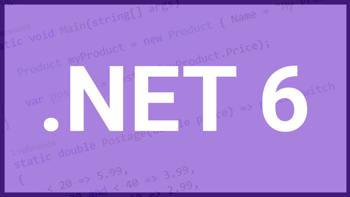This would mean that the contents within the namespace would be indented to the right.
However, with C#10, you can now declare a file scoped namespace at the top of the file. As a result, every object within that file will belong to that namespace.
// Framework.cs
namespace RoundTheCode.CSharp10.Models;
public class Framework
{
public string? Name { get; set; }
public int Version { get; set; }
public CodingLanguage? CodingLanguage { get; set; }
}The benefits of having a file scoped namespace is that you are reducing horizontal waste and it looks cleaner and tidier.
Feature #2: Record structs
C# 9 saw the introduction of record classes.
C# 10 takes the record keyword further, so you can now declare a struct as a record.
One of the benefits with record classes is that they can be immutable. Below is an example of how to declare an immutable struct record, and how to initialise it.
// Framework.cs
public readonly record struct Framework(string? Name, int Version, CodingLanguage? CodingLanguage);// CodingLanguage.cs
public readonly record struct CodingLanguage (string? Name);// FrameworkController.cs
[Route("framework")]
public class FrameworkController : Controller
{
[HttpGet("record-structs")]
public IActionResult RecordStructs()
{
var framework = new Framework
{
Name = ".NET",
Version = 6,
CodingLanguage = new CodingLanguage { Name = "C#" }
};
return Json(framework);
}
}There is no need to declare properties in a readonly record struct. Simply pass in the property names as constructors, and it will automatic bind the property names and their values to that struct.
Feature #3: Constant interpolated strings
Interpolated strings come in handy as it means you can add an object to a string without coming out of the string.
Before C# 10, interpolated strings were perfectly acceptable when declared as a var:
var languageReleasePrefix = "C# 10";
var languageRelease = $"{languageReleasePrefix} to be released in November 2021.";
return Json(languageRelease);However, if you change the personString to a const, it would throw an error.
But that's not the case with C# 10. You can now declare a interpolated string as a constant.
const string languageReleasePrefix = "C# 10";
const string languageRelease = $"{languageReleasePrefix} to be released in November 2021.";
return Json(languageRelease);Feature #4: Extended property patterns
Extended property patterns makes it cleaner to do a condition on a nested property.
Take this switch example. In C# 9, you would have to wrap nested properties in curly braces:
public static string GetFullCodingLanguageName(Framework framework) => framework switch
{
{ CodingLanguage: { Name: "C#" } } => "C Sharp",
_ => "(unknown)"
};But in C# 10, you now declare nested properties using a dot.
public static string GetFullCodingLanguageName(Framework framework) => framework switch
{
{ CodingLanguage.Name: "C#" } => "C Sharp",
_ => "(unknown)"
};Feature #5: Global using directive
Don't you just hate having to import the same namespaces multiple times for different classes?
Well in C# 10, there is a new global keyword that allows you to declare your common namespaces in your application.
It is recommended that you create a separate file to store your global namespaces. We have created a GlobalUsing.cs file and this how it looks:
// GlobalUsing.cs
global using Microsoft.AspNetCore.Mvc;
global using RoundTheCode.CSharp10.Models;This now means that we no longer have to declare these namespaces in each individual file.
See these new C# 10 features in action
Check out our YouTube feature where we demonstrate these features in action:



